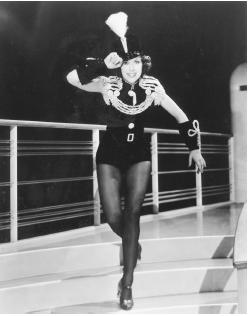Eleanor Powell - Actors and Actresses
Nationality:
American.
Born:
Springfield, Massachusetts, 21 November 1912.
Family:
Married the actor Glenn Ford, 1943 (divorced 1959), son: Peter.
Career:
Began studying ballet at age 6; appeared in Atlantic City clubs as a
child; 1928—dance debut with Co-Optimists troupe in New York; then
learned tap dancing; 1929—Broadway debut in
Follow Through
; 1935—film debut in
George White's Scandals
; 1936—lead role in film
Broadway Melody of 1936
; contract with MGM, and made series of successful musicals until 1940;
1953–56—created and acted in TV series
Faith of Our Children
; 1960–64—in musical revues in Las Vegas and New York.
Awards:
Five Emmys for
Faith of Our Children
TV series.
Died:
In Beverly Hills, California, 11 February 1982.
Films as Actress:
- 1935
-
George White's Scandals ( George White's 1935 Scandals )(White) (as Marilyn Collins); Broadway Melody of 1936 (Del Ruth) (as Irene Foster/Mlle. Arlette)
- 1936
-
Born to Dance (Del Ruth) (as Nora Paige)
- 1937
-
Broadway Melody of 1938 (Del Ruth) (as Sally Lee); Rosalie (Van Dyke) (title role)
- 1939
-
Honolulu (Buzzell) (as Dorothy March)
- 1940
-
Broadway Melody of 1940 (Taurog) (as Clare Bennett)
- 1941
-
Lady Be Good (McLeod) (as Marilyn Marsh)
- 1942
-
Ship Ahoy (Buzzell) (as Tallulah Winters)
- 1943
-
I Dood It ( By Hook or by Crook ) (Minnelli) (as Constance Shaw); Thousands Cheer (Sidney) (as featured performer)

- 1945
-
Sensations of 1945 ( Sensations ) (Andrew L. Stone) (as Ginny Walker)
- 1950
-
Duchess of Idaho (Leonard) (as featured performer)
Publications
By POWELL: articles—
"Eleanor Powell Talking to John Kobal," in Focus on Film (London), Autumn 1974 and Spring 1975.
Interview with John Kobal, in People Will Talk , New York, 1985.
On POWELL: books—
Thomas, Tony, That's Dancing! , New York, 1985.
Schultz, Margie, Eleanor Powell: A Bio-Bibliography , Westport, Connecticut, 1994.
Levin, Alice B., Eleanor Powell: First Lady of Dance , Madison, 1997.
On POWELL: articles—
Pérez, M., "Un Fusée pointée vers les planches: Eleanor Powell, des Scandales à la Broadway Melody de 1940," in Positif (Paris), February 1977.
Classic Images (Indiana, Pennsylvania), April 1982.
The Annual Obituary 1982 , New York, 1983.
Films in Review (New York), April 1984.
Classic Images (Muscatine), January 1995.
* * *
Eleanor Powell assumed the mantle of Hollywood's top female tap dancer from Ruby Keeler. But where one might question Keeler's dancing ability, Powell's films provide clear evidence that she danced without peer. This view seems confirmed by the Dance Masters of America who awarded her the title of world's greatest tap dancer and by MGM's willingness to showcase an unknown in her second film. MGM banked on America's tap-dancing craze during the 1930s to catapult Powell to immediate stardom; a gamble which paid off handsomely. Her weak acting and singing (she was usually dubbed by Marjorie Lane) failed to detract and she became a box-office smash. In 11 films from Broadway Melody of 1936 to Sensations of 1945 Powell remained the premier female tap dancer. Arturo Toscanini once said that the three things he would remember most about his trip to the West Coast were the sunset, the Grand Canyon, and Eleanor Powell's dancing. As she retired, Ann Miller literally followed in her footsteps to dominate tap during the late 1940s and early 1950s.
Powell incorporated acrobatics and ballet (which she studied first) into tap, creating a unique dance style that emphasized high kicks, rapid "grands pirouettes," "chain turns," and gymnastics. She also employed steps, positions, and movements usually reserved for men. Her aggressive and powerful technique ultimately classified her as a solo performer. As Fred Astaire said in Steps in Time , "She 'put 'em down' like a man, no ricky-ticky-sissy stuff with Ellie. She really knocked out a tap dance in a class by herself." The consistency of her dancing also offers sufficient evidence that she worked as her own choreographer.
All Powell's films, except Broadway Melody of 1940 , move to opulent finales which she dances without a partner; she does however dance with a chorus. In Broadway Melody of 1936 she performs in a glittering tuxedo surrounded by 30 male dancers in top hat and tails. In Born to Dance , Powell commands a battleship (set), its "crew," two military bands, and a battalion of women. In Rosalie , she dances with 34 West Point cadets and 500 extras. This solo emphasis created an obvious problem for MGM when casting romantic musical comedies. In fact, MGM could not find her a suitable dancing partner. No male dancer with whom she teamed could match her tap virtuosity; only Fred Astaire in Broadway Melody of 1940 proved an equal partner. (Their "Begin the Beguine" routine remains one of the most sublime performances in Hollywood musical history.) Consequently, MGM usually paired her with nondancing male stars such as Jimmy Stewart, Robert Taylor, and Nelson Eddie. Powell eventually courted seven leading men in nine films over an eight-year span, and even danced with Buttons the Dog in Lady Be Good and a horse in Sensations of 1945. Powell always portrayed a self-assured, intelligent, and independent woman, with strong and supportive female friends, interested in romance but not as an exclusive goal. Her idealized placement was reinforced by her comparison to other women in the films who ranged from gold-diggers to the freakish to the vain. This characterization reflected her dance routines which, as already mentioned, also upset the romantic comedy formula of female to male capitulation. During the late 1930s and early 1940s, such a persona undoubtedly added to her popularity.
—Greg S. Faller
Comment about this article, ask questions, or add new information about this topic: